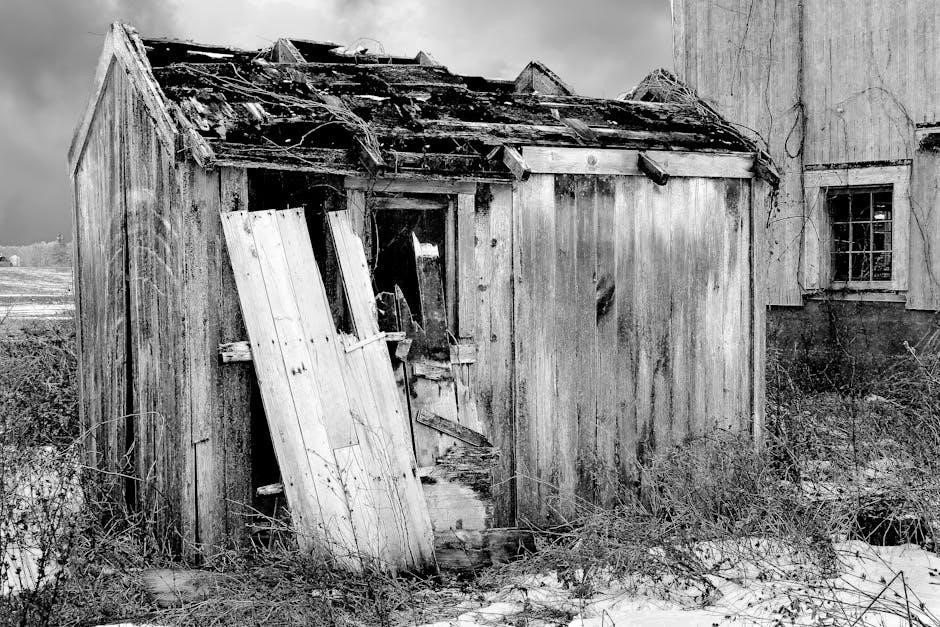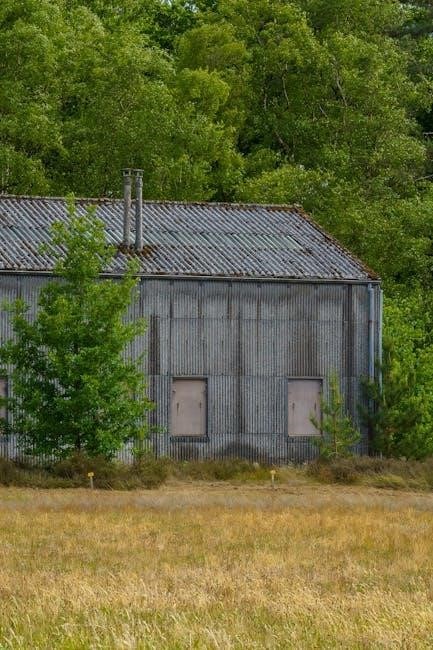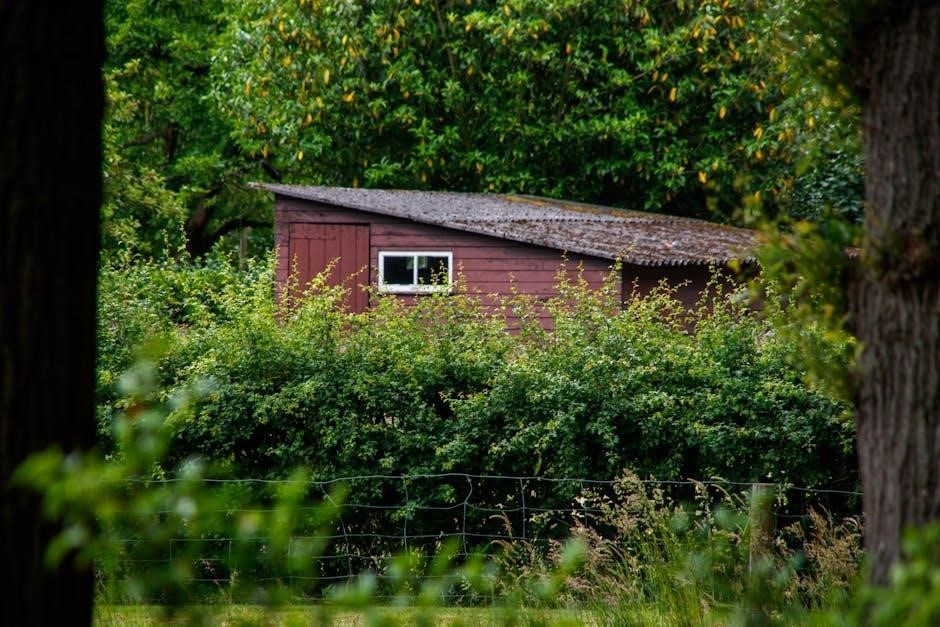Welcome to the Rubbermaid 7×7 shed assembly guide. This durable and stylish storage solution offers ample space for your outdoor needs. Follow these steps for a successful and safe assembly.
Overview of the Rubbermaid 7×7 Storage Shed
The Rubbermaid 7×7 storage shed is a versatile and durable outdoor storage solution designed to meet various needs. With its 7×7 feet footprint, it offers ample space for storing gardening tools, seasonal items, and outdoor equipment. Constructed from high-quality materials, this shed is built to withstand harsh weather conditions and maintain its appearance over time. Its double-walled construction ensures strength and stability, while the UV-protected panels prevent fading and cracking due to sunlight exposure. The shed’s design allows for easy assembly and disassembly, making it a convenient option for homeowners. It is also low-maintenance, requiring only occasional cleaning to keep it in excellent condition. Whether you need storage for small or large items, the Rubbermaid 7×7 shed provides a secure and organized space that complements any backyard setting.

Its sleek design ensures it blends seamlessly into outdoor environments while offering reliable performance and durability.
Importance of Following Assembly Instructions
Adhering to the provided assembly instructions is crucial for the successful installation of your Rubbermaid 7×7 storage shed. Proper assembly ensures the shed’s structural integrity, safety, and longevity. Deviating from the instructions can lead to misalignment, compromised durability, or even safety hazards. Additionally, the manufacturer’s warranty may be voided if the assembly does not follow the recommended guidelines. Always read through the manual thoroughly before starting, as it contains essential details about tools, materials, and techniques to ensure a smooth process. Correct assembly also guarantees that all parts fit securely, preventing issues like water leaks or panel damage. By following the instructions carefully, you can achieve a professional-grade finish and enjoy your shed for years to come. Remember, proper assembly is key to maximizing the shed’s performance and value.
Manufacturer’s Warranty and Disclaimer
Rubbermaid provides a warranty for the 7×7 storage shed, covering manufacturing defects under normal use and conditions. However, the warranty does not cover damages resulting from improper assembly, site preparation, or extreme weather conditions. The manufacturer disclaims liability for issues arising from failure to follow assembly instructions, improper anchoring, or misuse of the shed. It is the user’s responsibility to ensure the shed is assembled correctly and maintained properly. The shed is not intended for use by children, and standing or sitting on the roof is strictly prohibited. Any modifications or repairs not authorized by Rubbermaid may void the warranty. Always refer to the official manual for detailed warranty terms and conditions. By proceeding with assembly, you acknowledge acceptance of these terms and conditions.

Pre-Assembly Preparation
Ensure proper site selection, leveling, and foundation preparation before unpacking. Complete all site work and verify the area is clear and ready for assembly to proceed smoothly.
Site Selection and Leveling
Selecting the right location for your Rubbermaid 7×7 shed is crucial. Choose a flat, level, and dry area to ensure proper assembly and stability. Avoid low-lying spots where water may collect. Check local regulations for any specific requirements. Once the site is chosen, clear the area of debris and vegetation. Use a spirit level to ensure the ground is even. If necessary, level the ground by adding or removing soil. Proper leveling prevents uneven assembly and potential structural issues. For optimal drainage, ensure the site slopes slightly away from the shed. Anchoring the shed to the foundation will be easier if the site is well-prepared; A level surface also ensures the shed’s doors align correctly and function smoothly. Take your time during this step, as it lays the foundation for a successful assembly process.
Foundation Requirements
A sturdy foundation is essential for the stability and longevity of your Rubbermaid 7×7 shed. The shed must be assembled on a solid, level surface, such as a concrete slab, patio, or treated-wood platform. A well-prepared foundation ensures even weight distribution and prevents structural issues. For optimal results, the foundation should be slightly larger than the shed’s base dimensions. If using a concrete base, ensure it is fully cured before assembly. For a wooden platform, use pressure-treated wood to protect against rot and pests. Gravel bases are also acceptable but must be compacted and leveled properly. Always check local building codes for specific requirements. Anchoring the shed to the foundation is mandatory to prevent shifting due to wind or other forces. Properly securing the shed ensures safety and maintains its integrity over time.
Unpacking and Inventory of Parts
Begin by carefully unpacking all components from the boxes and verifying each item against the provided inventory list. Ensure no parts are missing or damaged. This step is crucial for a smooth assembly process. Organize the parts into categories, such as frame components, wall panels, roof sections, and hardware. Pay special attention to smaller items like screws, bolts, and clips, as they can easily be misplaced. Refer to the manual for labeled diagrams to identify each part. Before proceeding, lubricate the roof snaps as instructed to ease assembly. Double-check that all panels and frames are accounted for, and confirm the presence of essential hardware like hinges and locking mechanisms. Once everything is verified, you can proceed confidently to the next step. Proper organization now saves time and reduces the risk of delays during assembly.

Tools and Materials Needed
The essential tools include screwdrivers, wrenches, and hammers. Safety gear like gloves and goggles is recommended. Additional materials may include a ladder and level for precise assembly. Organize everything beforehand for efficiency.
Essential Tools for Assembly
Assembling the Rubbermaid 7×7 shed requires specific tools to ensure a smooth and efficient process. Start with a screwdriver, both Phillips and flathead, to handle various screws. A wrench or socket set is necessary for securing bolts and tight-fitting parts. A hammer will come in handy for tapping pieces into place gently. Additionally, a rubber mallet can prevent damage to the panels during assembly. A utility knife or saw may be needed for trimming excess material or cutting packaging. For precise alignments, a level and measuring tape are indispensable. A power drill with screwdriver and drill bits can speed up the process. Organize all tools beforehand to avoid delays. Safety gear, such as gloves and goggles, is also recommended to protect yourself during assembly. Having these tools readily available ensures you can follow the instructions without interruptions.
Recommended Safety Equipment
Ensuring your safety during the assembly of the Rubbermaid 7×7 shed is crucial. Start by wearing safety goggles to protect your eyes from debris or falling particles. A pair of gloves is essential to provide grip and prevent injuries from sharp edges or heavy lifting. A dust mask is recommended if you plan to cut or sand any materials during the process; Steel-toe boots are also advisable to protect your feet from heavy tools or accidental drops. Additionally, keep a first aid kit nearby in case of minor accidents. Proper lighting and a stable ladder (if needed) will help maintain visibility and balance. Avoid wearing loose clothing that could get caught in tools. By prioritizing safety, you can assemble your shed confidently and avoid potential hazards.
Additional Materials for Site Preparation
Preparing your site properly ensures a smooth assembly process. Begin by gathering materials like gravel or treated wood for the foundation to create a level surface. A shovel and rake are necessary for leveling the ground. Sand or concrete may also be required depending on the foundation type. A carpenter’s level tool is essential to ensure the site is perfectly even. Additionally, consider having sandpaper to smooth any rough edges on the foundation materials. If using a wooden platform, weatherproof glue and nails will secure the boards. Lastly, a tarp or plywood can be placed under the shed for added protection against moisture. These materials will help create a stable and durable base for your Rubbermaid 7×7 shed, ensuring long-term performance and structural integrity.

Step-by-Step Assembly Process
Begin with site preparation and foundation setup, then assemble the base and frame. Install wall panels, followed by roof panels, ensuring proper alignment. Finally, attach doors and hardware, securing all components tightly for a sturdy structure.
Base Assembly and Frame Construction
Start by unpacking and organizing all components. Ensure the site is level and the foundation is prepared. Begin with the base assembly, attaching side panels and rear panels securely. Use the provided hardware to tighten all connections firmly. Next, construct the frame by aligning the front and rear panels with the base. Snap the roof supports into place, ensuring proper alignment with the ridge beam. Lubricate the roof snaps as instructed to facilitate easy assembly. Raise the left roof panel, ensuring arrows face inward, and guide it into the ridge beam. Repeat for the right roof panel, securing both sides evenly. Double-check all connections and ensure the frame is stable before proceeding to wall or roof installation.
Wall Panel Installation
Attach the wall panels to the base and frame, ensuring each panel aligns with the corresponding edges. Secure the panels using the provided clips and screws, tightening firmly but avoiding over-tightening. Start with the rear and side panels, then proceed to the front panel, making sure all connections are snug and even. Use a rubber mallet to tap panels into place if necessary. Verify that all tabs and slots fit correctly, and check the alignment of each panel with the frame. Once all wall panels are installed, ensure the structure is stable and even. Properly aligning the panels is crucial for the roof installation and overall durability of the shed. Double-check all connections before moving on to the roof assembly.

Roof Panel Assembly and Alignment
Begin by preparing the roof panels according to the manufacturer’s instructions. Lubricate the roof snaps on the gable sections to ensure smooth installation. Carefully lift the left roof panel and align it with the front left side of the shed, ensuring the arrows on the panel face inward. Secure the panel to the ridge beam using the provided hardware. Repeat the process for the right roof panel, making sure it aligns perfectly with the left panel. Tighten all screws firmly to create a watertight seal. Use a rubber mallet to tap panels into place if necessary. Once both panels are installed, check the alignment and ensure the roof is level and evenly spaced. Proper alignment and secure fastening are critical for weather resistance and structural integrity. Double-check all connections before proceeding to the final assembly steps.
Door and Hardware Installation
Attach the door handles and hardware according to the instructions. Align the hinges properly on the door frame and shed structure. Ensure the doors hang evenly and close securely. Use the provided screws to tighten all connections firmly. Check the door alignment to ensure proper closure and functionality. Make sure the doors do not sag or rub against the frame. If necessary, adjust the hinges for optimal alignment. Once installed, test the doors by opening and closing them several times to confirm smooth operation. Secure the shed by attaching the locking mechanism as specified in the instructions. Ensure all hardware is tightly fastened to prevent loose parts over time. Proper installation of doors and hardware is essential for secure storage and long-term durability. Double-check all connections before finalizing this step.

Final Adjustments and Touch-Ups
After completing the assembly, ensure the shed is level and secure. Tighten all bolts and screws, and align panels properly. Anchor the shed to the foundation for stability. Check door functionality and make any necessary adjustments. Perform a final inspection to ensure all parts are correctly installed and functioning as intended. Address any gaps or misalignments for a polished finish. Ensure the shed is ready for use and withstands environmental conditions. Complete any final touch-ups, such as cleaning or lubricating hinges, for optimal performance and longevity. Your Rubbermaid 7×7 shed is now fully assembled and ready for secure storage.
Securing the Shed to the Foundation
Properly anchoring your Rubbermaid 7×7 shed ensures stability and prevents shifting due to wind or other forces. Begin by positioning the shed on the prepared foundation, ensuring it is level and evenly aligned. Use the anchor kit provided or recommended by the manufacturer, following the instructions carefully. Typically, this involves attaching brackets to the shed’s base and securing them to the foundation using screws or bolts. For concrete foundations, drill into the surface and insert anchor bolts. For wooden platforms, screw the brackets directly into the framing. Tighten all anchors firmly to create a solid connection. Double-check that the shed is level and plumb after securing. If unsure about the process, consult a professional or refer to the assembly manual. Proper anchoring ensures the shed remains safe and secure, even in harsh weather conditions. Regularly inspect the anchors to ensure they remain tight and functional.
Aligning and Tightening All Parts
Once the major components of the shed are assembled, it is crucial to ensure all parts are properly aligned and securely fastened. Begin by checking the base, walls, and roof panels for correct positioning and alignment. Use a level to verify that all surfaces are even and plumb. If necessary, gently adjust panels or frames to achieve proper alignment. Next, tighten all bolts, screws, and connectors in the specified order, starting from the base and working upward. Avoid overtightening, as this may warp or damage the panels. Pay special attention to the roof snaps, ensuring they are securely locked into place. Finally, perform a thorough inspection to confirm that all parts are tightly fastened and aligned correctly. Proper alignment and tightening are essential for the structural integrity and long-term durability of your Rubbermaid 7×7 shed.
Final Inspection and Testing
After completing the assembly, conduct a thorough final inspection to ensure all components are correctly installed and functioning as intended. Start by visually inspecting the entire structure, checking for any gaps, misalignments, or loose parts. Verify that the doors open and close smoothly and that the roof is securely attached with no signs of sagging. Test the durability of the walls and base by applying gentle pressure to ensure stability. Check all hardware, such as hinges and latches, to confirm they are properly secured and functioning smoothly. Additionally, inspect the roof snaps and ensure they are tightly locked to prevent water infiltration. Finally, perform a walk-through to ensure the shed is square, level, and ready for use. This final step ensures your Rubbermaid 7×7 shed is safe, durable, and ready to withstand various weather conditions.

Safety Precautions and Maintenance
Ensure safety by never standing on the roof and conducting regular inspections. Maintain durability by cleaning and securing loose parts promptly, especially after extreme weather conditions.

Safety Guidelines During Assembly

Always prioritize safety when assembling your Rubbermaid 7×7 shed. Wear protective gear like gloves and safety glasses to prevent injuries. Ensure the area is clear of obstacles and tripping hazards. Avoid standing or sitting on the roof, as it is not designed to support weight. Keep children and pets away from the assembly site. Use proper lifting techniques to prevent strain. Follow all instructions carefully to avoid misalignment or structural issues. Secure the shed to the foundation immediately after assembly to ensure stability. Regularly inspect the shed for damage, especially after extreme weather conditions. Store sharp tools and small parts out of reach of children. Treat the shed with care in extreme temperatures to maintain its durability. By adhering to these guidelines, you can ensure a safe and successful assembly process.
Post-Assembly Maintenance Tips
Regular maintenance is essential to ensure your Rubbermaid 7×7 shed remains durable and functional.Clean the shed regularly, removing dirt and debris from walls and roof panels to prevent damage. Inspect the shed for any signs of wear or tear, such as cracks or loose fasteners, and address them promptly. Lubricate moving parts like door hinges to maintain smooth operation. Ensure the shed remains anchored securely to the foundation to withstand wind and weather conditions. Avoid storing heavy items on the roof, as it is not designed to support additional weight. Periodically check the foundation for levelness and stability. Keep the surrounding area clear of vegetation to prevent moisture buildup. By following these maintenance tips, you can extend the lifespan of your shed and ensure it continues to serve its purpose effectively.
Troubleshooting Common Issues
During or after assembly, issues may arise with your Rubbermaid 7×7 shed. If roof panels misalign, check the ridge beam alignment and ensure all clips are securely attached. For door installation problems, verify that hinges are properly aligned and screws are tightened evenly. If the shed appears unstable, inspect the foundation for levelness and tighten all bolts. Water leakage may occur if roof panels are not properly sealed; inspect and tighten all connectors. If panels are damaged, contact customer support for replacements. Ensure all parts are inventoried and correctly labeled before assembly to avoid missing components. Regularly inspect for loose hardware and tighten as needed. Addressing these issues promptly will ensure your shed remains structurally sound and functional. Always refer to the manufacturer’s guidelines for specific solutions and warranty claims.
